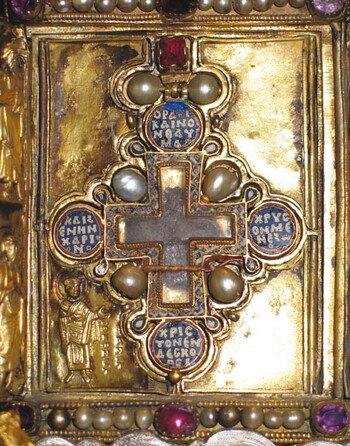Byzantine Epigrams
The epigram occupies an important place in Byzantine literature, following the ancient tradition. Various poets composed concise poems of varying length, in most cases for a specific purpose. Epigrams convey the artistic ambitions of Byzantine poets through their language, their metrical form and their rhetorical and poetical layout; in addition, they are significant sources for various facets of the spiritual and material culture of the Byzantine Empire. While literary epigrams transmitted in manuscripts as part of their author’s work are relatively well attested, the study of non-literary or “inscriptional” epigrams has long been neglected.
Systematic work on the project, which is based on preliminary research by Wolfram Hörandner, started in 2005. It aims to assemble a complete record of inscriptional Byzantine epigrams (600–1500 A.D), i.e. of those verses which are preserved on the object for which they were composed.
The collected material (from publications and in situ) is divided into four volumes, three of which have already been published (author A. Rhoby): epigrams on frescoes and mosaics verlinkt mit verlag.oeaw.ac.at/Byzantinische-Epigramme-auf-Fresken-und-Mosaiken (2009), epigrams on icons and portable objects (2010), epigrams on stone (2014), epigrams in illuminated manuscripts (2018).
The fourth volume deals with Byzantine epigrams in illuminated manuscripts, i.e. with verses which function as marginal poetry of depictions, as verses accompanying scenes and figure poems. This study also contributes to questions of donorship and “self-fashioning”.
The volumes are arranged according to the following model: introduction, description of the object, critical edition of the Greek text, German translation, commentary on content and linguistical-philological questions, images.
Accompanying studies are primarily devoted to various questions about the interaction of word, image and beholder.
The project’s aim is to achieve a better knowledge of the Byzantine epigram, i.e. its contents, forms and functions as well as its socio-cultural significance.
Inscriptional epigrams were also created in the post-Byzantine period, until the 19th century. A list of incipits / a checklist clearly demonstrates this phenomenon: doi.org/10.1553/Postbyzantinische_Epigramme
It is closely related to the project “Epigraphy”.
PROGRAMME OF THE EVENING LECTURE ON THE OCCASION OF THE COMPLETION OF THE PROJECT, 6 JUNE 2018
Images of the lecture evening, 6 June 2018 ((c) A. Rhoby, E. Schiffer)
Publications
- A. Rhoby, Byzantinische Epigramme auf Fresken und Mosaiken (= Byzantinische Epigramme in inschriftlicher Überlieferung, vol. 1) (Veröffentlichungen zur Byzanzforschung 15). Wien 2009
- A. Rhoby, Byzantinische Epigramme auf Ikonen und Objekten der Kleinkunst (= Byzantinische Epigramme in inschriftlicher Überlieferung, vol. 2) (Veröffentlichungen zur Byzanzforschung 23). Wien 2010
- A. Rhoby, Byzantinische Epigramme auf Stein (= Byzantinische Epigramme in inschriftlicher Über-lieferung, vol. 3) (Veröffentlichungen zur Byzanzforschung 35). Wien 2014
- A. Rhoby, “When the year ran through six times of thousands …”: The Date in (Inscriptional) Byzantine Epigrams, in: St. Efthymiadis et al. (eds.), “Pour une poétique de Byzance”. Hommage à Vassilis Katsaros (Dossiers byzantins 16). Paris 2015, 223–242
- A. Rhoby, Labeling Poetry in the Middle and Late Byzantine Period. Byzantion 85 (2015) 259–283
- A. Rhoby (nach Vorarbeiten von R. Stefec), Ausgewählte byzantinische Epigramme in illuminierten Handschriften. Verse und ihre "inschriftliche" Verwendung in Codices des 9. bis 15. Jahrhunderts (= Byzantinische Epigramme in inschriftlicher Überlieferung, vol. 4) (Veröffentlichungen zur Byzanzforschung 42). Wien 2018
- A. Rhoby - Peter Schreiner, Antiquitates Constantinopolitanae im Osmanischen Reich: Johannes Malaxos und seine Aufzeichnungen im Vat. Reg. Gr. 166. Misellanea Bibliothecae Apostolicae Vaticanae 24 (2018) 605-657
- A. Rhoby, Postbyzantinische Epigramme in inschriftlicher Überlieferung (PBEiÜ). Incipitarium und Checklist
- A. Rhoby, Post-Byzantine Metrical Inscriptions and Their Context, in: Διεθνές επιστημονικό συμπόσιο προς τιμήν του ομότιμου καθηγητή Γεωργίου Βελένη. Θεσσαλονίκη, Αμφιθέατρο Αρχαίας Αγοράς, 4-7 Οκτωβρίου 2017. Πρακτικά / International Symposium in Honour of Emeritus Professor George Velenis. Thessaloniki, Amphitheatre of Ancient Agora, 4-7 October 2017. Proceedings. Athen 2021, 1527–1540

